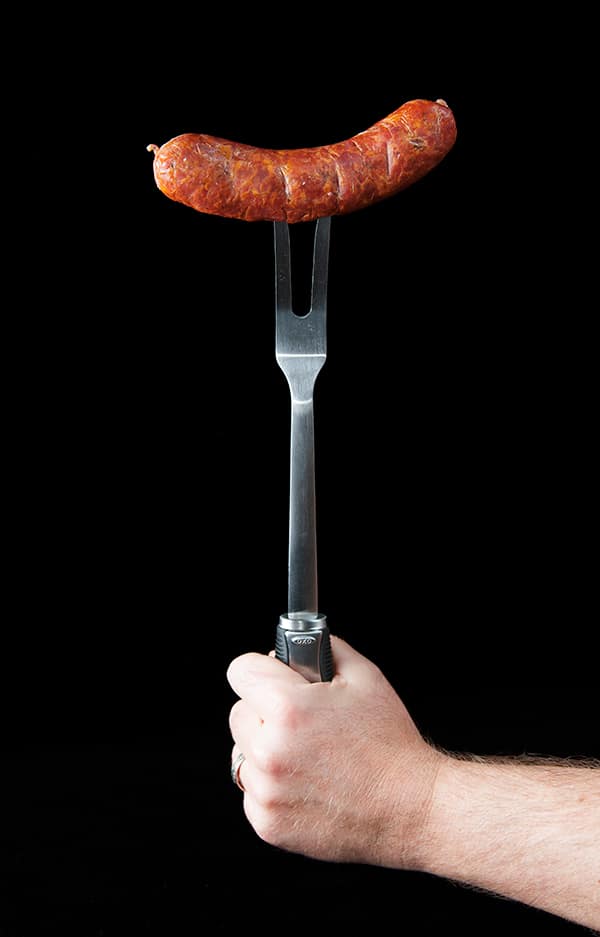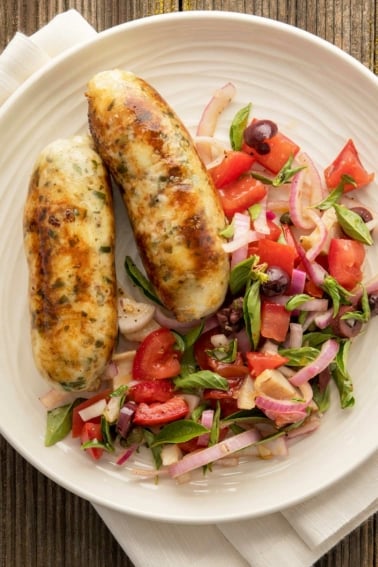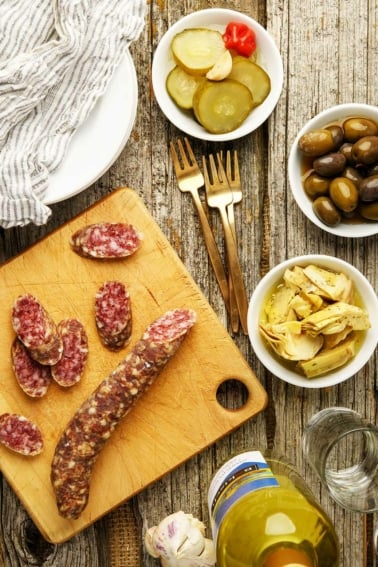As an Amazon Associate I earn from qualifying purchases.

Linguica. It’s part of the culinary fabric of California’s great Central Valley, available at every greasy spoon from Redding to Bakersfield, served at breakfast, lunch and dinner. You can thank the Azoreans for this one.
I’ve heard tell that there are more Azoreans in California than there are in the Azores, which, if you are not familiar, are a small chain of islands off the coast of Portugal. You can see their names everywhere around here: Silva, Lopes, Mendes, Machado, Costa, Cardoza. Linguica eaters, all.
What is this strange sausage of which I speak? Linguica (Ling-GWEE-zuh) is a pork sausage heavily spiced with paprika, chiles and garlic. There are all sorts of variations, but linguica is normally a coarse, country sausage, and it is often smoked. I’ve eaten linguica all over the country, but the best have been in Gloucester, Massachusetts (where my mother and sister live), and here in the Valley.
A really good linguica, to my mind, is a cudgel of a sausage. Smoky, garlicky and rich with pork fat and red peppers, it is spectacular served with grilled onions on a hoagie roll. A man’s sandwich.
The Portuguese put linguica in almost everything, but in addition to sandwiches, I love it in soups with Portuguese cabbage (which is a lot like our collard greens) and potatoes. My friend David Leite has several good recipes using linguica in his cookbook The New Portuguese Table.
I made my version with wild pig. Of course if you can’t get wild boar, you can use pork. But use good-quality pork from a good butcher or a farmer’s market. I suppose you could also use bear, too, if you have that lying around.
If you’ve never made sausage before, start by reading this detailed tutorial on how to make sausages at home.
Portuguese Linguica
Ingredients
- 3 1/2 pounds pork shoulder or wild boar meat
- 1 1/2 pounds pork fat
- 34 grams kosher salt
- 6 grams Instacure No. 1 (optional)
- 1 tablespoon dextrose or white sugar
- 10 garlic cloves, minced
- 1 tablespoon sweet paprika
- 1 teaspoon hot paprika or cayenne
- 1 teaspoon smoked paprika (optional)
- 1 tablespoon dried oregano
- 1 tablespoon crushed black pepper
- 1/2 cup dry milk (optional - it helps the sausage retain moisture while smoking)
- 3/4 cup red wine, preferably a Portuguese wine
- Hog casings
Instructions
- Chill the meat and fat until they're almost frozen by putting it in the freezer for an hour or so.
- Take out some hog casings -- you'll need about 3 to 4 standard lengths, about 15 feet -- and set in a bowl of very warm water.
- Chop meat and fat into chunks that will fit into your grinder. Combine the salt, instacure (if using), sugar, garlic, dry milk and the rest of the spices and mix it into the meat and fat with your hands. Let this rest in the fridge for about an hour. (Optional expert step: Mix the chunks of meat and fat with the salt and curing salt overnight before proceeding. Doing this will give you a better bind on the sausage.)
- Grind through your meat grinder using the coarse die, about 6.5 mm or so. If your room is warmer than 69°F, set the bowl for the ground meat into another bowl of ice to keep it cold. Put the mixture back in the freezer while you clean up.
- Add the wine to the meat mix, then mix thoroughly either using a Kitchenaid on low for 60-90 seconds or with your (very clean) hands. This is important to get the sausage to bind properly. Once it is mixed well, put it back in the fridge while you clean up again.
- Stuff the sausage into the casings. Do whole coils before making links. Twist off links by pinching the sausage down and twisting it, first in one direction, and then with the next link, the other direction. (Here's a quick video on making the links) Or you could tie them off with butcher’s string.
- Hang the sausages in a cool place. If it is warm out or if you are smoking your links, hang for one hour. If you have a place where the temperature will not go higher than 38°F, you can hang them as long as overnight.
- If you are smoking your sausages, get your smoker going while the sausages hang. Smoke the links for at least 3 hours, and as many as 12. I prefer a lighter smoke, so you can still taste the pork and spices. I prefer oak, but hickory, maple, pecan or a fruit wood would also work.
- Once the sausages have dried and/or smoked, put them the fridge until needed. If you are freezing the sausages, wait a day before doing so. This will tighten up the sausages and help them keep their shape in the deep-freeze.
Notes
Nutrition
Nutrition information is automatically calculated, so should only be used as an approximation.





Double the red wine and experience heaven. You’ll thank me later.
NETO sausage company in california was the best in 50’s and 60’s
The red is produced by three things the Cure, sodium nitrate in Prague powder or insta cure. the Paprika and a little from smoking, up the red add more paprika I like mine with alot of it. There are also fresh not cured versions that are not red at all
Mr. Shaw,
Two questions: Can the linguica be placed in the freezer without smoking. I will be frying linguica before consumption. I made linguica before but it did not finish with that familiar red color, what should I be doing to get the red coloring? Thank you.
Arthur: The red color is from smoking. But yes, you can skip the smoking step. It will taste different from regular linguica though.
Hey Hank,
Will these sausages have a “bite” similar to kielbasa?
Greetings, the recipe calls for either wild boar meat or pork shoulder. I am assuming that wild boar would be much leaner, so if using domestic pork shoulder should a person cut back on how much pork fat to add?
Brad: Yes. If you have regular, fatty pork shoulder, you can skip the straight fat altogether and use 100% shoulder.
Dude, how many people have boar? That is a MAJOR asterisk in your recipe, which is excellent otherwise. I kindly suggest an edit to protect your fans from fatty sausage.
Andrew: Boar = pork. No difference.
My Daughter. loves your food. She walks in the room and says it smells good mom thank you for the added cheeriness of our morning. With love an awesome mom.
I grew up in the Central Valley as well, and I’ve loved Linguica from an early age. I’m sitting here waiting to throw a batch made from wild boar and locally sourced pork into the smoker.
The skillet test was great, I can’t wait to try out the smoked version! My mom would simmer half-links in red wine for a couple hours and serve with eggs for one of my favorite breakfasts.
Made this but doubled the cayenne and added a few more garlic cloves after making a taster patty. For me personally, I think it needed more paprika, but I also think the optional addition of the smoked paprika might have been what I was looking for. I smoked mine about two hours on apple wood until it reached 165°. All in all I think this is a good recipe I am still enjoying, and will tweak to my taste.
Lucky’s market here in Tallahassee makes it fresh and smoked over oak. Doing a Low Country Boil tonight to see how that goes. I have always before put on the charcoal grill. By far the best sausage I have ever tasted. If you like garlic flavor, this is for you!
Is it a cold smoke?
Andrew: It can be. I typically smoke cold-ish, at about 165F.
Sounds like a great recipe! Is there an approx. fat ratio you are looking for? I assume your wild hog is much more lean than anything at the local butcher.
Joe: Yes, about 20 to 35 percent fat, depending on your preference.
I enjoyed this recipe and used javelina. Thanks, Hank!
Howdy Hank,
In your reply to Dusty you said precision is required and you use volume. Did you mean weight and if not how do you get precise on 34 grams by volume? When curing I’ve used weight for precisely determining the amount of salt and No. 1 pink salt to be used.
Thanks,
Chris
Chris: Oops! Yes, I mean weight.
Okay class, who can tell me how many tablespoons are in 34 grams…anyone…(crickets)
Dusty: No way to tell without telling me what sort of salt you are using. I always use volume, not weight, for sausage making because you need precision to get the same result every time. If this is not important to you, 34 grams of Diamond Crystal kosher salt is about 2 tablespoons.
Hi, if smoking the sausage, do you recommend ice water immersion when taking from the smoker, as in your kielbasa recipe? Or is kielbasa some how more prone to shrivelling than linguica is (although I can’t see why it would be…).
Thanks!
Scott: Yep, that is always a good idea.
Wife was born and raised there, near Gasbars in Fall River. She, just yesterday got a care package from her dad… 5 pounds of Portuguese Chourico! (Aside from, “a bit of dosh”)! It’s just killing me though that I can’t find a recipe for Portuguese “Chourico” that isn’t for 50 plus pounds! We need maybe a 10 pound recipe. Been making sausage for most of my life and love doing it, but that recipe eludes me! First sausage maker is/was an 1876 cast iron wonderful machine and held 2 gallons. Finally retired it this year and went with Kichen Aid attachments to stuff the hog skins as we do. Help Us! If you can with that recipe! Much thanks
Get linguica from fall river Massachusetts
Ron, try Goularts in the Bay Area. It is really good. We make our own using a 100 year old secret recipe from our Dad, who was from Lisbon.
I’m still looking for “my grandfather’s linguisa. He was from Fiaal. He retired in Santa Cruz, California. Everywhere I go in the US , I have butcher shops make me linguisa- Nothing is close to the OLD WORLD I crave. Suggestions please. Thx Ron